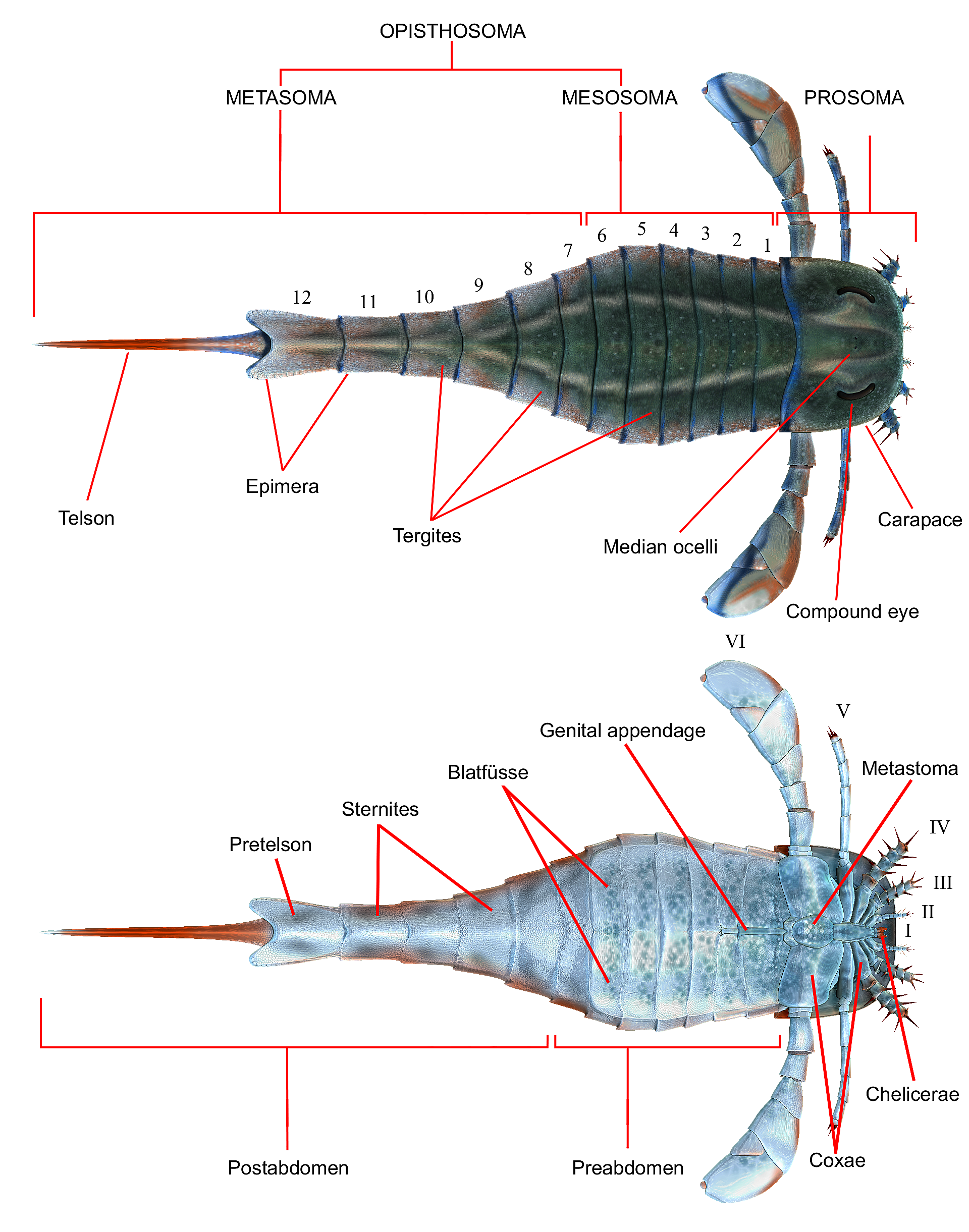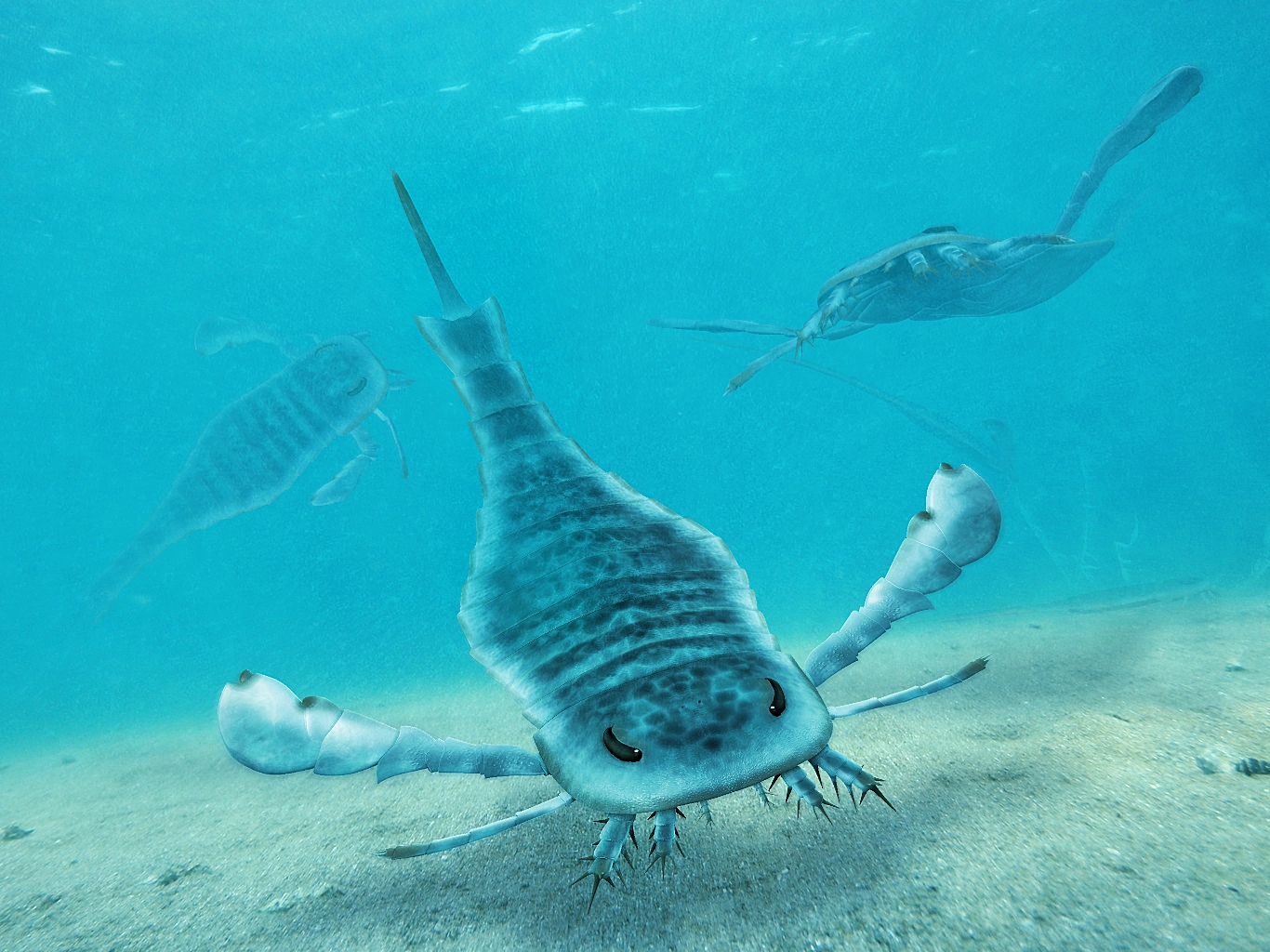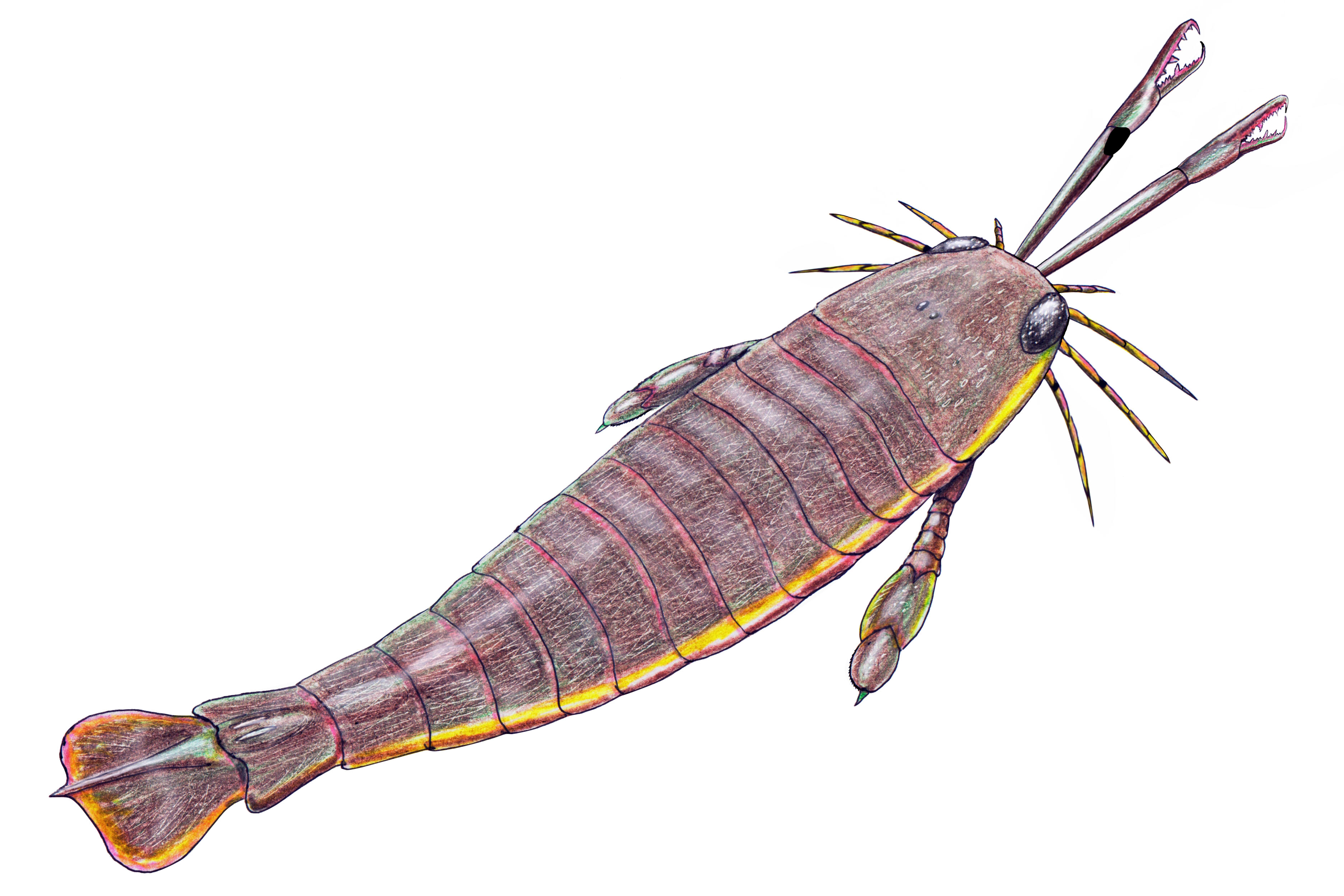|
Waeringopteridae
Waeringopteridae is a family of eurypterids, an extinct group of aquatic arthropods. The Waeringopteridae is the only family classified as part of the superfamily Waeringopteroidea, which in turn is classified within the infraorder Diploperculata in the suborder Eurypterina. The earliest known member of the group, '' Orcanopterus'', has been recovered from deposits of Katian (Late Ordovician) age and the latest known surviving member, ''Grossopterus'', has been recovered from deposits of Siegenian (Early Devonian) age. The name Waeringopteridae is derived from the type genus '' Waeringopterus'', which is named in honor of eurypterid researcher Erik N. Kjellesvig-Waering. Waeringopterid fossils are very rare and the family only contains five known species classified in three different genera (''Waeringopterus'', ''Orcanopterus'' and ''Grossopterus''). Four of these species are from the ancient continent of Laurentia, with the only species known from outside of it being a Devonian ... [...More Info...] [...Related Items...] OR: [Wikipedia] [Google] [Baidu] |
Eurypterid
Eurypterids, often informally called sea scorpions, are a group of extinct arthropods that form the Order (biology), order Eurypterida. The earliest known eurypterids date to the Darriwilian stage of the Ordovician period 467.3 Myr, million years ago. The group is likely to have appeared first either during the Early Ordovician or Late Cambrian period. With approximately 250 species, the Eurypterida is the most diverse Paleozoic Chelicerata, chelicerate order. Following their appearance during the Ordovician, eurypterids became major components of marine faunas during the Silurian, from which the majority of eurypterid species have been described. The Silurian genus ''Eurypterus'' accounts for more than 90% of all known eurypterid specimens. Though the group continued to diversify during the subsequent Devonian period, the eurypterids were heavily affected by the Late Devonian extinction event. They declined in numbers and diversity until becoming extinct during the Permian–Tri ... [...More Info...] [...Related Items...] OR: [Wikipedia] [Google] [Baidu] |
Orcanopterus
''Orcanopterus'' is a genus of a eurypterid classified as part of the family Waeringopteridae. The genus contains one species, ''O. manitoulinensis'', from the Ordovician of Manitoulin, Canada. Morphology Limbs ''Orcanopterus'' is estimated to be up to long. Like all eurypterids, it had six pairs of limbs, the hindmost of which were broad flat paddles. The first pair of limbs in ''Orcanopterus'' are unknown, but were presumably small chelicerae for eating with. The second to fourth pairs of limbs were heavily spined and around 7–8 cm long. The second pair of limbs had four podomeres but is poorly preserved and no spines can be made out. The third pair had four podomeres and three forward-facing spines. The fourth had three podomeres with forward-pointing spines and the fifth pair of limbs had four podomeres, all with spines and with the final podomere a long spine. Its sixth pair of limbs were flat paddles with nine podomeres - the ninth one is unusually large. Thre ... [...More Info...] [...Related Items...] OR: [Wikipedia] [Google] [Baidu] |
Grossopterus
''Grossopterus'' is a genus of prehistoric eurypterid classified as part of the family Waeringopteridae. The genus contains two species, ''G. inexpectans'' from Gilboa, United States and ''G. overathi'' from Overath, Germany.Dunlop, J. A., Penney, D. & Jekel, D. 2015. A summary list of fossil spiders and their relatives. In World Spider Catalog. Natural History Museum Bern, online at http://wsc.nmbe.ch, version 16.0 http://www.wsc.nmbe.ch/resources/fossils/Fossils16.0.pdf (PDF). See also * List of eurypterids This list of eurypterid genera is a comprehensive listing of all genera that have ever been included in the order Eurypterida, excluding purely vernacular terms. The list includes all commonly accepted genera, but also genera that are now conside ... References Devonian eurypterids Diploperculata Devonian arthropods of Europe Devonian arthropods of North America Eurypterids of Europe {{eurypterid-stub ... [...More Info...] [...Related Items...] OR: [Wikipedia] [Google] [Baidu] |
Eurypterina
Eurypterina is one of two suborders of eurypterids, an extinct group of chelicerate arthropods commonly known as "sea scorpions". Eurypterine eurypterids are sometimes informally known as "swimming eurypterids". They are known from fossil deposits worldwide, though primarily in North America and Europe. Seventy-five percent of eurypterid species are eurypterines; this represents 99% of specimens. The superfamily Pterygotioidea is the most species-rich clade, with 56 species, followed by the Adelophthalmoidea with 43 species; as sister taxa, they comprise the most derived eurypterines. Pterygotioidea includes the pterygotids, which are the only eurypterids known to have a cosmopolitan distribution. Though more numerous both in specimens and taxa, the eurypterines have the shorter temporal range of the two eurypterid suborders. They first appeared around the same time as the Stylonurina in the Middle Ordovician. The suborder faced a slow extinction during the Middle and Late Devo ... [...More Info...] [...Related Items...] OR: [Wikipedia] [Google] [Baidu] |
Late Ordovician
The Ordovician ( ) is a geologic period and system, the second of six periods of the Paleozoic Era. The Ordovician spans 41.6 million years from the end of the Cambrian Period million years ago (Mya) to the start of the Silurian Period Mya. The Ordovician, named after the Welsh tribe of the Ordovices, was defined by Charles Lapworth in 1879 to resolve a dispute between followers of Adam Sedgwick and Roderick Murchison, who were placing the same rock beds in North Wales in the Cambrian and Silurian systems, respectively. Lapworth recognized that the fossil fauna in the disputed strata were different from those of either the Cambrian or the Silurian systems, and placed them in a system of their own. The Ordovician received international approval in 1960 (forty years after Lapworth's death), when it was adopted as an official period of the Paleozoic Era by the International Geological Congress. Life continued to flourish during the Ordovician as it did in the earlier Cambrian Pe ... [...More Info...] [...Related Items...] OR: [Wikipedia] [Google] [Baidu] |
Carapace
A carapace is a Dorsum (biology), dorsal (upper) section of the exoskeleton or shell in a number of animal groups, including arthropods, such as crustaceans and arachnids, as well as vertebrates, such as turtles and tortoises. In turtles and tortoises, the underside is called the plastron. Crustaceans In crustaceans, the carapace functions as a protective cover over the cephalothorax (i.e., the fused head and thorax, as distinct from the abdomen behind). Where it projects forward beyond the eyes, this projection is called a rostrum (anatomy), rostrum. The carapace is Calcification, calcified to varying degrees in different crustaceans. Zooplankton within the phylum Crustacea also have a carapace. These include Cladocera, ostracods, and Isopoda, isopods, but isopods only have a developed "cephalic shield" carapace covering the head. Arachnids In arachnids, the carapace is formed by the fusion of prosomal tergites into a single Plate (animal anatomy), plate which carries the e ... [...More Info...] [...Related Items...] OR: [Wikipedia] [Google] [Baidu] |
Tagmata (arthropod Anatomy)
In biology, a tagma (Greek: τάγμα, plural tagmata – τάγματα - body of soldiers; battalion) is a specialized grouping of multiple segments or metameres into a coherently functional morphological unit. Familiar examples are the head, the thorax, and the abdomen of insects. The segments within a tagma may be either fused (such as in the head of an insect) or so jointed as to be independently moveable (such as in the abdomen of most insects). Usually the term is taken to refer to tagmata in the morphology of members of the phylum Arthropoda, but it applies equally validly in other phyla, such as the Chordata. In a given taxon the names assigned to particular tagmata are in some sense informal and arbitrary; for example, not all the tagmata of species within a given subphylum of the Arthropoda are homologous to those of species in other subphyla; for one thing they do not all comprise corresponding somites, and for another, not all the tagmata have closely analogous f ... [...More Info...] [...Related Items...] OR: [Wikipedia] [Google] [Baidu] |
Prosoma
The cephalothorax, also called prosoma in some groups, is a tagma of various arthropods, comprising the head and the thorax fused together, as distinct from the abdomen behind. (The terms ''prosoma'' and ''opisthosoma'' are equivalent to ''cephalothorax'' and ''abdomen'' in some groups.) The word ''cephalothorax'' is derived from the Greek words for head (, ') and thorax (, '). This fusion of the head and thorax is seen in chelicerates and crustaceans; in other groups, such as the Hexapoda (including insects), the head remains free of the thorax. In horseshoe crabs and many crustaceans, a hard shell called the carapace covers the cephalothorax. Arachnid anatomy Fovea The fovea is the centre of the cephalothorax and is located behind the head (only in spiders).Dalton, Steve (2008). ''Spiders; The Ultimate Predators''. A & C Black, London. P.p. 19. . It is often important in identification. It can be transverse or procurved Smith, A. M. (1990c). Baboon spiders: Tarantulas of Afr ... [...More Info...] [...Related Items...] OR: [Wikipedia] [Google] [Baidu] |
Opisthosoma
The opisthosoma is the posterior part of the body in some arthropods, behind the prosoma (cephalothorax). It is a distinctive feature of the subphylum Chelicerata (arachnids, horseshoe crabs and others). Although it is similar in most respects to an abdomen (and is often referred to as such), the opisthosoma is differentiated by its inclusion of the respiratory organs (book lungs or book gills) and the heart. Segments The number of segments and appendages on the opisthosoma vary. Scorpions have 13, but the first is only seen during its embryological development. Other arachnids have fewer; harvestmen, for instance, have only ten. In general, appendages are absent or reduced, although in horseshoe crabs they persist as large plate-like limbs, called opercula or branchiophores, bearing the book gills, and that function in locomotion and gas exchange. In most chelicerates the opisthosomal limbs are greatly reduced and persist only as specialized structures, such as the silk-producing ... [...More Info...] [...Related Items...] OR: [Wikipedia] [Google] [Baidu] |
Telson
The telson () is the posterior-most division of the body of an arthropod. Depending on the definition, the telson is either considered to be the final segment of the arthropod body, or an additional division that is not a true segment on account of not arising in the embryo from teloblast areas as other segments. It never carries any appendages, but a forked "tail" called the caudal furca may be present. The shape and composition of the telson differs between arthropod groups. Crustaceans In lobsters, shrimp and other decapods, the telson, along with the uropods, forms the tail fan. This is used as a paddle in the caridoid escape reaction ("lobstering"), whereby an alarmed animal rapidly flexes its tail, causing it to dart backwards. Krill can reach speeds of over 60 cm per second by this means. The trigger time to optical stimulus is, in spite of the low temperatures, only 55 milliseconds. In the Isopoda and Tanaidacea (superorder Peracarida), the last abdominal b ... [...More Info...] [...Related Items...] OR: [Wikipedia] [Google] [Baidu] |
Carcinosomatid
Carcinosomatidae (the name deriving from the type genus ''Carcinosoma'', meaning "crab body")Meaning osomaat ''www.dictionary.com''. Retrieved 7 September 2018. is a family of eurypterids, an extinct group of aquatic arthropods. They were members of the superfamily Carcinosomatoidea, also named after ''Carcinosoma''. Fossils of carcinosomatids have been found in North America, Europe and Asia, the family possibly having achieved a worldwide distribution, and range in age from the Late Ordovician to the Early Devonian. They were among the most marine eurypterids, known almost entirely from marine environments. Carcinosomatids varied considerably in size, from species only a few centimetres in length to some of the largest known arthropods. The largest carcinosomatid species, ''Carcinosoma punctatum'', reached lengths of at least and rivalled the largest eurypterid of all, ''Jaekelopterus'', in size. Morphologically, carcinosomatids were highly distinct from other eurypterids, know ... [...More Info...] [...Related Items...] OR: [Wikipedia] [Google] [Baidu] |
Pterygotid
Pterygotidae (the name deriving from the type genus ''Pterygotus'', meaning "winged one") is a family of eurypterids, an extinct group of aquatic arthropods. They were members of the superfamily Pterygotioidea. Pterygotids were the largest known arthropods to have ever lived with some members of the family, such as ''Jaekelopterus'' and '' Acutiramus'', exceeding 2 metres (6.6 ft) in length. Their fossilized remains have been recovered in deposits ranging in age from 428 to 372 million years old (Late Silurian to Late Devonian). One of the most successful groups of eurypterids, the pterygotids were the only eurypterid family to achieve a truly worldwide distribution. Several evolutionary innovations made the pterygotids unique among the eurypterids, with large and flattened telsons (the posteriormost division of the body) likely used as rudders to provide additional agility and enlarged chelicerae (frontal appendages) with claws. These claws were robust and possessed teeth ... [...More Info...] [...Related Items...] OR: [Wikipedia] [Google] [Baidu] |







